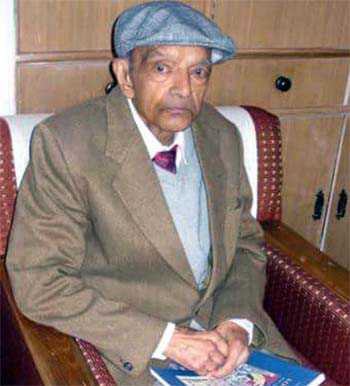Shriniwas Joshi
Dr Vidya Chand Ohri, a deserving Padma award material for the state and art historian of immense calibre, went into long sleep on February 28 after completing 92 years of his life’s journey (see photo). Dr BN Goswami, his guide for the thesis “Chamba Paintings” and his taught Vijay Sharma have been bestowed with the award, but not Ohri, because this state could not assess his worth - he was marginalised here, but respected by the nation and recognised by the international comity.
Dr WG Archer, ICS, curator of the Indian section of Victoria Albert Museum, London, writes to him in 1976 when he got doctorate from Panjab University, “I have always had a good opinion of your scholarly powers. Your quietly modest manner conceals a real ability to think and I believe that some major discoveries that you have made such as the agreement made by Balwant Singh of Jammu have been of the first rate importance.”
Professor Walter Spink of the University of Massachusetts too had testified his “professional excellence”. His articles on Chamba, Garhwal, Kullu-Mandi, Mankot and Nurpur paintings were published in Macmillan Dictionary of Art, London, 1996. Although he could not get the deserving national award, yet he had a keen eye for picking up many a gifted person and molding them to be award winners. Can Gopu Ram of the Pabbar valley (woodwork), Maheshi and Lalita Vakil (Chamba Rumal), Prakash and Hakim (metalwork), Latif (wood carving), Vijay (Pahari paintings) and several others ever forget him for his invaluable guidance that has taken them to the pinnacles of glory?
Karl Khandalwala, then Chairman of Prince of Wales Museum, Mumbai, writes about Dr Ohri, “Most learned authority on hill sculpture and hill metal images.” No doubt, his book “Sculpture of the Western Himalayas: History and Stylistic Development” is the only researched book of its kind and regarded as magnum opus in this discipline.
The Ohris belong to Sapri Mohalla of Chamba town. Vidya Chand’s father Prithi Chand, along with his wife Hardei, left Chamba to work in a Timber Company at the Jhelum (now in Pakistan) where Vidya Chand was born on November 24, 1923. They returned to Chamba when this child was a toddler. Hardly had he cleared the matriculation examination than his father expired.
He had to join as laboratory technician in a hospital at Chamba. Having served there for a couple of years, he shifted to Bhuri Singh Museum at Chamba as clerk. That time there was no Language and Culture Department and the Education Department though the Inspector of the Schools used to run the museum. Ohri, who had gained knowledge about the art objects in the museum, was appointed gallery assistant there in 1958. He studied on his own and did postgraduation in history and was posted as the curator of the museum in 1962 after clearing a UPSC interview.
He was always immaculately dressed, shaved and bathed daily and never climbed the bed with socks on. His son Rakesh told me that minutes before his death he removed his socks himself and when Rakesh offered to help, he refused and said, “By doing your own job, you gain self-confidence.” He then lied down in the bed, had just two hiccups, and was gone to meet his wife who had left for heavenly abode barely six months ago. His daughter told me that he was such an ardent reader of the books and The Tribune that he would read the paper daily using a high-powered reading glass and showed me this habit of his in photographs taken on mobile.
His interest in preserving the traditional Pahari dresses as curator contributed the Gujjari kurta to the fashion-world. Charles Fabri, the well known art critic, had said: “Posterity will be grateful to Dr Ohri for doing stupendous work in the field of textiles.”
He established the State Museum at Shimla which was inaugurated by the first Governor of the full-fledged state, S Chakravarti, on January 26, 1974. Ohri retired from there in 1985 as curator. His books and papers are many but his sterling qualities were sobriety, cool-headedness and wisdom. Not for nothing, he was referred to as one who concealed a thinking mind behind modest manners.
TAILPIECE
“I think, therefore, I am.” – Rene Descartes
—The writer is a retired bureaucrat.
Unlock Exclusive Insights with The Tribune Premium
Take your experience further with Premium access.
Thought-provoking Opinions, Expert Analysis, In-depth Insights and other Member Only Benefits
Already a Member? Sign In Now











